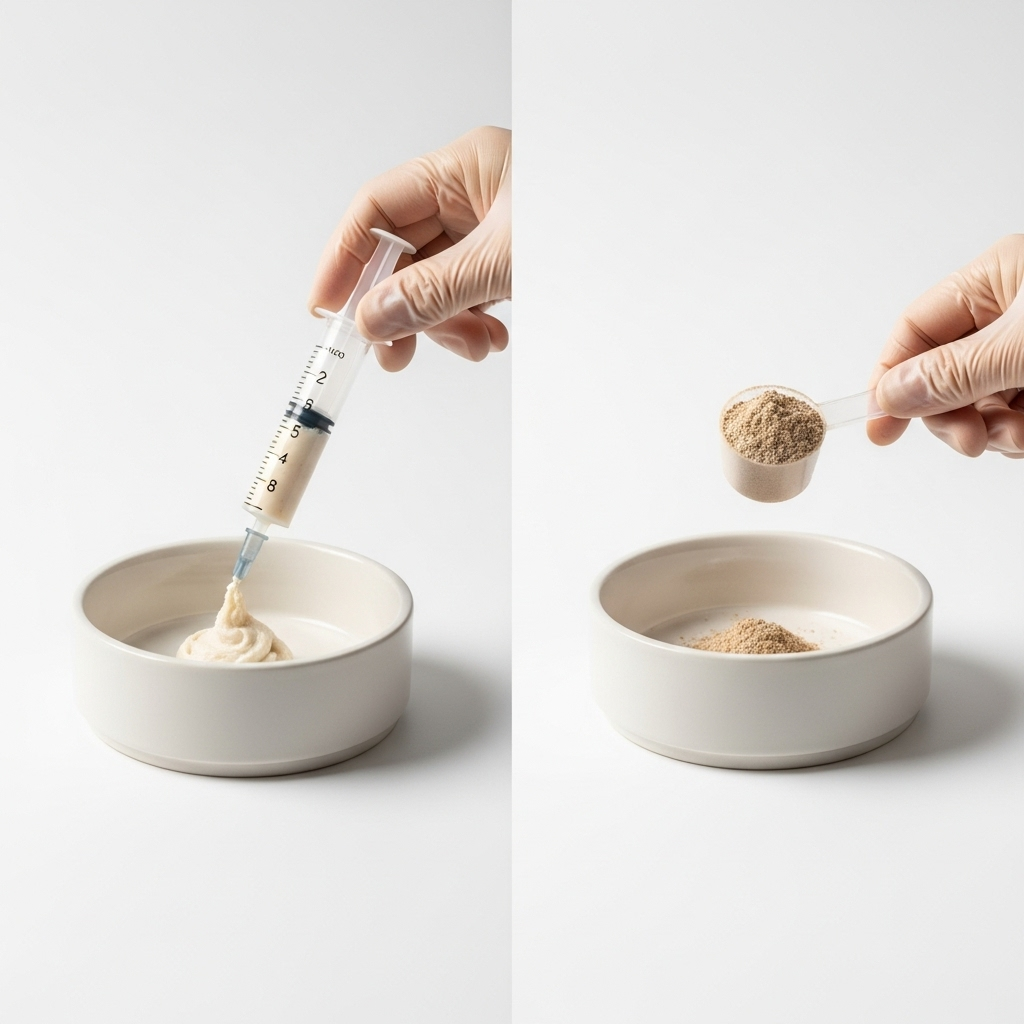Probiotic Paste vs Powder for Cats: Which Works Best?

Many cat owners consider probiotics to support digestion, reduce occasional diarrhea, or help during and after antibiotic courses. Two common formats are paste (or gel) and powder. Choosing the right form depends on your cat’s preferences, your lifestyle, and the health goals for your pet. This guide compares paste vs powder for cats, explains how each works, and offers practical tips to help you decide safely and effectively.
How feline probiotics work (brief)
Probiotics are live microorganisms that can help balance the gut microbiome. In cats, commonly used strains include Enterococcus faecium, various Lactobacillus species, Bifidobacterium species, Bacillus coagulans, and the yeast Saccharomyces boulardii. Benefits may include improved stool consistency, support during dietary changes, and assistance restoring flora after antibiotics. Results vary by strain, dose, and the individual cat.
Key differences: paste vs powder
Probiotic paste (gel)
Paste usually comes in a syringe or tube and is often flavored to increase palatability. It’s typically pre-measured by push of the syringe or marked lines on the tube, which can make dosing easier for small cats. Pastes are convenient for direct oral delivery (rub on the gums or into the mouth) and for cats that won’t eat sprinkled products.
Probiotic powder
Powdered probiotics are sprinkled onto wet food or mixed into treats. Powders can be more flexible for dosing adjustments and can be easier to store in some formulations. They’re handy when you prefer to hide probiotics in food or when treating multiple animals with different dosages.
Factors to consider when choosing
- Palatability: Paste is often flavored and accepted by picky cats; powders can be missed if mixed with dry food.
- Dosing accuracy: Paste often provides a measured dose; powders require careful measuring for accurate CFUs per dose.
- Administration method: Paste can be applied directly to gums or paw; powder must usually be mixed with food (wet food works best).
- Strain & formulation: Check the specific strains and CFU per dose. Some powders contain prebiotics (fibers) as well, which may or may not be desirable depending on your cat.
- Stability and storage: Some probiotics require refrigeration; others are shelf-stable. Both paste and powder formulations can be either, depending on manufacturing.
- Use during antibiotics: Certain strains (e.g., Saccharomyces boulardii) are yeast and can be taken with antibiotics. Timing for bacterial probiotics is often staggered (separate dosing from antibiotic by a few hours).
- Convenience: Paste is quick when administering directly; powder is convenient if your cat reliably eats its food each meal.
Pros and cons
| Format | Pros | Cons |
|---|---|---|
| Paste | Easy, pre-measured dosing; usually palatable; good for picky eaters or direct oral dosing | Can be more expensive per dose; flavorings may not suit all cats; less flexible mixing into food |
| Powder | Flexible dosing; easy to mix in wet food; often less costly per dose | Can be rejected if mixed with dry food; measuring errors possible; some cats won’t eat their food with powder added |
How to administer safely
- Read the label for strain, CFU per dose, and instructions. Use a veterinary formulation when possible.
- Introduce slowly: start with a half dose for 2–3 days and watch for tolerance (looser stool, gas).
- For paste: aim for the inner cheek or gums for best acceptance. Reward with a small treat if needed.
- For powder: mix into a small portion of strong-smelling wet food to ensure the cat eats the full dose.
- If your cat is on antibiotics, ask your veterinarian when to give the probiotic and whether a yeast-based strain is preferred.
- Stop and consult your vet if you see worsening diarrhea, vomiting, lack of appetite, or other concerning signs.
When powder or paste may be better
- Choose paste if your cat is a fussy eater, needs precise dosing, or you need a quick oral delivery.
- Choose powder if you want to mix into meals, treat multiple pets with variable doses, or if paste flavors are rejected.
- If your cat has a central line, severe immunosuppression, or is critically ill, ask your veterinarian before starting any probiotic.
Practical tips for choosing a product
- Check the label for specific strains and CFU per dose at time of manufacture and, ideally, guaranteed until expiration.
- Choose products formulated for cats or veterinary-recommended options rather than guessing with human supplements.
- Prefer brands that provide storage instructions, third-party testing, or verified potency claims.
- Avoid unnecessary additives, sugars, or high-calorie flavorings if your cat is overweight or diabetic.
FAQ
1. How long before I see results?
Some cats show improvement in stool consistency within a few days, but it can take 2–4 weeks for more noticeable or lasting changes. If there’s no improvement after a month, consult your veterinarian.
2. Can I give human probiotics to my cat?
Many human probiotics contain strains and doses intended for people and may not be ideal for cats. Always check with your veterinarian before using human products; veterinary formulations are preferred.
3. Are probiotics safe with antibiotics?
Often yes, but timing matters. Some vets recommend giving probiotics a few hours after antibiotics. Yeast-based probiotics (e.g., Saccharomyces boulardii) are not affected by antibiotics and can be given concurrently. Ask your vet for guidance.
4. What if my cat refuses the paste or powdered food?
Try a different flavor or mix powder with a small amount of especially appealing wet food. For paste, apply to a paw so your cat grooms it off, or place a small dab on the gums. If refusal persists, consult your veterinarian for alternatives such as capsules or veterinary compounding.
Key Takeaways
- Both paste and powder can be effective; the best choice depends on your cat’s preferences and your need for dosing accuracy.
- Paste is convenient and often better for picky eaters or direct oral dosing; powder is flexible and easy to mix into wet food.
- Check strains, CFU per dose, storage requirements, and manufacturer guidance; veterinary formulations are preferred.
- Introduce probiotics gradually and monitor your cat for tolerance and effectiveness.
- Always consult your veterinarian before starting probiotics, especially if your cat is ill, on medication, or immunocompromised.
Disclaimer
This article is informational and not a substitute for veterinary advice. For diagnosis, treatment, or recommendations tailored to your cat’s health, consult your veterinarian. If your cat shows severe symptoms (persistent vomiting, bloody diarrhea, lethargy, or rapid deterioration), seek veterinary care promptly.

Leave a Reply